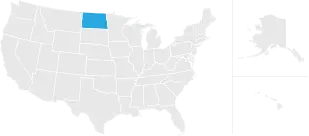
Overview of North Dakota Taxes
North Dakota levies a progressive state income tax with three brackets based on income level. The state is notable for its low income tax rates, which range from 0% to 2.50%. No North Dakota cities charge local income taxes.
| Gross Paycheck | $-- | ||
| Taxes | --% | $-- | |
| Details | |||
| Federal Income | --% | $-- | |
| State Income | --% | $-- | |
| Local Income | --% | $-- | |
| FICA and State Insurance Taxes | --% | $-- | |
| Details | |||
| Social Security | --% | $-- | |
| Medicare | --% | $-- | |
| State Disability Insurance Tax | --% | $-- | |
| State Unemployment Insurance Tax | --% | $-- | |
| State Family Leave Insurance Tax | --% | $-- | |
| State Workers Compensation Insurance Tax | --% | $-- | |
| Pre-Tax Deductions | --% | $-- | |
| Details | |||
| Post-Tax Deductions | --% | $-- | |
| Details | |||
| Take Home Salary | --% | $-- | |
North Dakota Paycheck Calculator

North Dakota Paycheck Quick Facts
- North Dakota income tax rate: 0% - 2.50%
- Median household income: $77,871 (U.S. Census Bureau)
- Number of cities that have local income taxes: 0
How Your North Dakota Paycheck Works
It can be tricky to figure out what your take-home pay will be, since it’s not as simple as dividing your annual income by the number of pay periods. Regardless of where you live, if you’re legally employed, you’re going to have taxes taken out of your paycheck before it hits your bank account.
Your North Dakota employer withholds federal income taxes and FICA taxes from all of your paychecks. When you start any new job, you will complete a W-4 form that details information about any dependents you have, your salary and your tax filing status. Federal income taxes are withheld based on the information included on your W-4.
The IRS made major revisions to the Form W-4 in recent years. This new iteration no longer asks you to list total allowances, as it now requires filers to enter annual dollar amounts for income tax credits, non-wage income, itemized and other deductions and total annual taxable wages. The form also uses a five-step process that lets you indicate any additional income or jobs and other personal information.
The FICA taxes are Social Security and Medicare taxes. The government gets a total of 12.4% of your income for Social Security taxes and 2.9% for Medicare taxes. You only pay 50% of that amount, while your employer pays the other half. If your filing status is single, head of household or qualifying widow(er), any income you have above $200,000 is also subject to a Medicare surtax of 0.9%. If you're married and file jointly, this tax applies to all wages in excess of $250,000. Married couples who file separately pay this surtax on all wages above $125,000. Your employer doesn’t match the surtax.
If you’re self-employed or an independent contractor, you’re responsible for covering the full amount of your FICA taxes on your own. This is a lot of money, so make sure to look for all the deductions or credits you can find during tax time. There is actually a deduction designed to help self-employed workers by deducting the “employer” half of the FICA taxes.
North Dakotans are in a favorable position as far as state income taxes are concerned. North Dakota levies one of the lowest progressive state income taxes in the country, with rates ranging from 0% to 2.50%. This top rate is among the lowest of the states that have an income tax.
North Dakota's state income tax system comprised just three brackets, down from five in previous years. Here's how they currently look:
A financial advisor can help you understand how taxes fit into your overall financial goals. SmartAsset’s free tool matches you with vetted financial advisors who serve your area, and you can have a free introductory call with your advisor matches to decide which one you feel is right for you. If you’re ready to find an advisor who can help you achieve your financial goals, get started now.
If you're planning a move to the Peace Garden State, you'll be relieved to know that no cities levy local income taxes. And if your move has you planning on purchasing a home, check out our North Dakota mortgage guide for information about rates and getting a mortgage.
How You Can Affect Your North Dakota Paycheck
While you can’t control all of the money that comes out of your paycheck, there are steps you can take to affect your take-home pay. The primary influence you can have on your paycheck involves how you choose to fill out your Form W-4. The information you include, such as your filing status, number of dependents and more, dictates how much an employer should withhold.
One step you can take to adjust the amount of taxes you pay is to add money to a tax-advantaged retirement account, such as a 401(k) or 403(b). These accounts take pre-tax money, which means they come out of your pay before income taxes do. The result is that you lower your taxable income. You can contribute pre-tax money into medical expense accounts like a health savings account (HSA) or flexible spending account (FSA). These accounts allow you to save money for things like copays and prescriptions.

